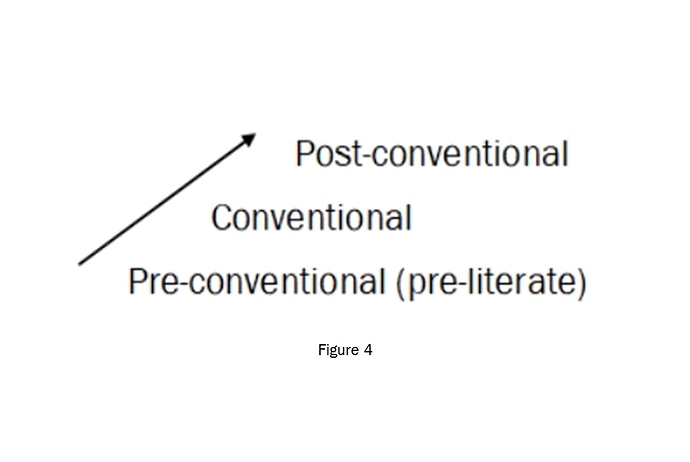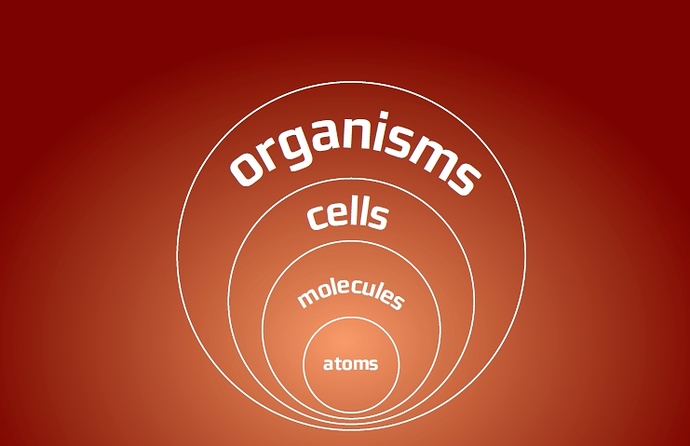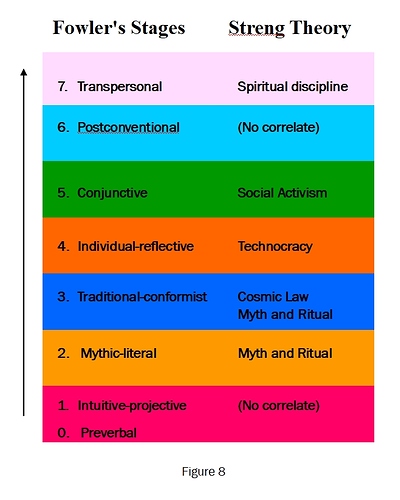In Part 2 of this series, I argued that if our aim is to understand religion rather than dismiss it, the best approach is to take as best we can the subjective point of view of the individual believer, adherent, or practitioner. That led us to a system of comparative religion called Streng Theory, whose key idea is that religion is a means toward ultimate transformation. The Streng team used their definition to identify 8 ways of religious life, 8 different means of working toward an ultimate resolution of life’s deepest concerns.
Today I will talk about another way of understanding the varieties of religious experience based on the research of developmental psychologists, especially those who looked specifically at religious or spiritual development. Developmental studies were only just emerging in the 1970’s and were apparently unknown to the Streng theorists. Building on their breakthrough work and retaining the parts of it that have lasting value, we can use a developmental model to afford us a deeper and more powerful understanding of religious life.
What do we mean by development in general? Most people are aware—however imperfectly—that humans develop through various stages from infancy to early childhood to adolescence, to adulthood. We commonly refer to this process as “growing up,” which suggests a series of stages or levels through which individuals normally become more physically mature, more knowledgeable, more self-confident, more sociable, more responsible, and so on, as they move over time from lower to higher stages of development.
This chart illustrates a simple 4-stage process of physical growth that most of us can relate to:
Figure 1 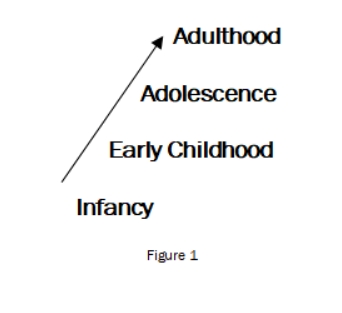
However, physical growth is far from the whole story of human development. Our minds develop as well. We have all kinds of capacities or potentials for interior growth from cognitive to moral to interpersonal to artistic to kinesthetic and others, including spiritual, as we shall see. All of these exhibit a stage structure of development over time. Take, for example, the well-known stages of cognitive development, as researched by Jean Piaget.
Figure 2 (from Wikipedia)
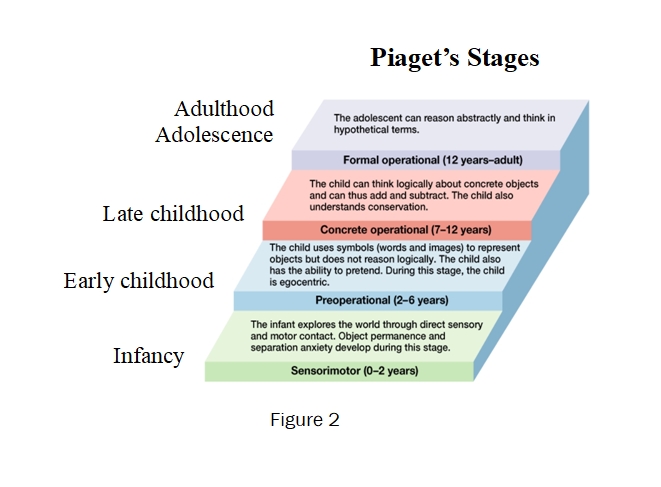
The chart shows the normal cognitive development of a person from birth to adulthood in 4 distinct stages over a certain average period of time. Earlier stages are lower or less complex in the sense that at those levels, a person is able to perform only a limited range of intellectual functions compared to stages that emerge later in life. So the progression is from lower to higher. Now ‘higher’ does not mean ’better,’ but simply ‘capable of more complex thinking.’
Piaget was a pioneer. Since his time, many other human capacities have been studied from a developmental perspective. These are called lines of development or, following Howard Gardner, multiple intelligences. Figure 3 displays a few of over 100 intelligences that have been researched to date.
Figure 3
This is a psychograph for some hypothetical person. The numbers on the vertical axis represent levels or stages of personal development. The arrows represent some of the many lines of potential development or growth available to all human beings. These develop relatively independently of one another, as indicated by the different lengths of the arrows. The chart adopts the color coding system used by Spiral Dynamics and other developmental systems for ease in referring to the various stages in a given intelligence line.
Careful research over several decades has shown that each of the multiple intelligences has a stage-structure, beginning with a simple level of complexity and proceeding to more and more complex levels of consciousness. Complexity here means degree of functionality. A person at a higher level can do and understand more things than they could at a lower level.
Take for example, our capacity for language. On a simple 3-stage model shown here in Figure 4, at Stage 1, proto-language—the first attempts at vocal communication— appears early in a child’s life in the form of baby talk. Stage 2 emerges as the child starts to become socialized. She begins to drop the infantile language that is no longer adequate and learns conventional ways of speaking, using words and sentences. Later at Stage 3 she can learn the rules of grammar and syntax, a higher order of linguistic understanding and skill.
Figure 4
Now you probably realize that this model is far too simple to capture all of the important types of possible growth in language ability. Indeed, a more granular map might display one or more stages within each of the three basic ones, yielding a six or eight-stage model. And that’s fine. The main point is that linguistic ability, along with all the rest of our human potentials, develops in the individual through a number of identifiable stages from lower (less complex) to higher (more complex).
Another important feature of development is that the skills acquired by an individual at early stages do not disappear. Basic language skills are retained and carried forward all the way to adulthood. Adults with a very sophisticated understanding of grammar, rhetoric, and linguistics can still talk like babies, if they want to. Thus, as growth unfolds, the lower stages of language development are transcended but also partially included in the progression to higher stages. This process—which is enacted across all lines—is often referred to as transcend-and-include. This is the same process that we see in biological evolution. Figure 5 shows how it works:
Figure 5Atoms combine to form molecules, molecules join to form cells, cells come together to form organisms. Each higher stage adds features not possessed by the earlier stages—that’s transcendence, but lower levels remain as necessary components of the higher levels—that’s inclusion. Figure 6 shows how ‘transcend—and include’ works in the development of language.
Figure 6 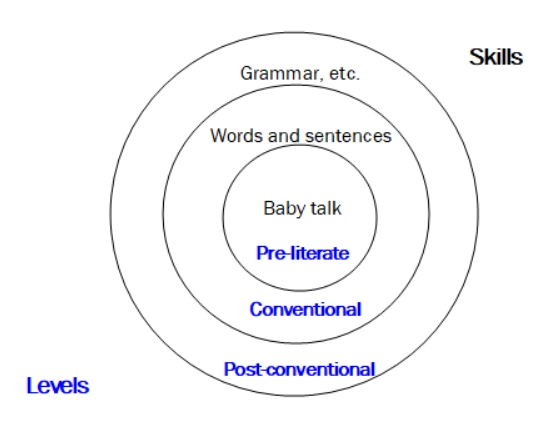
With these ideas in mind, let’s take a closer look at the spiritual/religious line of development we first saw in Figure 3. Going forward I will be using ‘spiritual’ and ‘religious’ interchangeably. As we proceed, bear in mind that we are defining ‘religion’ as a means toward ultimate transformation.
Researchers who study this phenomenon share the view of Streng Theory, described in Part 2 of this series, that from their earliest years, humans have ultimate concerns about their survival, health, safety, social belonging, love, self-esteem, and the specter of death. We now know that those concerns and the means of dealing with them change during the process of normal growing up and that spiritual growth unfolds in stages. The Streng Theory model does a good job of identifying some cross-cultural religious types, but it contains no notion of religious development. That is probably because the nature of development in religious consciousness was not well understood in the 1970’s and 80’s when Streng and company were working on their system.
The task of exploring spiritual intelligence was first taken up early in the 20th century by James M. Baldwin at Princeton Univ. and later by Daniel P. Brown of Harvard University. What they found is that religious consciousness in individuals evolves as a distinct line of development through a number of relatively permanent stages or levels,
How many stages are there? Despite differences among researchers, there is widespread agreement on six to eight major stages or levels of spiritual development in individuals from the earliest appearance of consciousness to the highest known transpersonal levels of enlightenment. Figure 7 is adapted from the work of James Fowler who investigated ‘Stages of Faith’ or spiritual intelligence as a line of development in humans.
Figure 7
What are the characteristics of each of the stages in Fowler’s model? Roughly, they are as follows:
· At Stage 0, the Preverbal stage, the infant’s ultimate concerns are for food and warmth. We can call this Archaic spirituality.
- At Stage 1, the Projective-magical, an egocentric and magical spirituality emerges with primitive self-consciousness. Ultimate concerns expand to include safety, sex, and survival. Magic rituals, animism, and shamanism are typical expressions in the context of a family or clan.
· At Stage 2, the Mythic-literal, ultimate reality is seen as spirits and power gods, embodied in concrete stories or myths acted out in tribal rituals. Spells, blessings, and curses are means of control of dangerous forces. Victory against tribal enemies is valued as an ultimate transformation
· At Stage 3, the Conventional-conformist stage, belonging, redemption, and salvation become ultimate concerns; the means of transformation include worship of a supreme deity or cosmic order. mythic membership in an organized, hierarchical religious community, conformity of belief, and strict adherence to a moral code.
· At stage 4, the Individual-reflective, rational spirituality emerges in the individual who realizes that science and rational thinking, not myth or religious authority, are the only reliable sources for acquiring knowledge of the universe. Ultimate reality is the natural world governed by mechanistic laws, and ultimate transformation is achieved through material gain and progress through science and technology.
· At stage 5, the Conjunctive, the individual holds a pluralistic, relativistic worldview which is critical of scientific absolutism and technocracy and is sensitive to the sufferings of marginalized groups. Ultimate reality is the Great Web of Life, and various forms of self-improvement, social networking, environmentalism, and grassroots activism are means toward a just transformation of global economic and political systems.
· At stage 6, the Postconventional, an integrated, holistic spirituality inspires the individual who sees the unfolding of Spirit in cosmic evolution as ultimate reality. A cosmocentric worldview allows him or her to discern partial truth and value at all levels of human development. Holistic thinking, spiritual practice, and compassionate action are the means toward an ultimate transformation of self and society.
· At stage 7, the Transpersonal, the highly evolved person has attained spiritual enlightenment, Nirvana, the Supreme Identity, Being Itself, or union with the One, etc, Mystical insight reveals the unreality of the ego and the unity of all phenomena. Ultimate transformation manifests as freedom from attachments, bliss, and deep compassion for all sentient beings. Often the fully realized person becomes a teacher of wisdom and spiritual disciplines such as meditation and yoga.
Obviously Fowler’s vertical classification of religions differs sharply from the horizontal one used by Streng Theory. The Streng Theory model rightly presents the various ways of being religious as equally valid, as options for anyone to study and choose among for their own spiritual practice. However it lacks an understanding of spiritual development. By contrast, Fowler’s system shows a growth hierarchy of spiritual orientations from magical to transpersonal in which at each higher stage, one’s religious worldview becomes more inclusive, attitudes become less egocentric and more compassionately embracing, and spiritual practices offer more effective means of achieving the highest available stages of spiritual fulfillment.
Can the two systems—Streng’s and Fowler’s— be integrated in some way? I think so. First of all, the definition of ‘religion’ as a means toward an ultimate transformation works for both approaches (or for any other, as I have argued). Secondly, as you can see in Figure 8, the eight ‘Ways of Being Religious’ in Streng theory can be mapped alongside Fowler’s integral spectrum, ….thus revealing developmental relationships among String Theory’s “8 Ways of Being Religious.”
Figure 8
Streng Theorists, being postmodernists, may not agree with my reconstruction of their theory, but some sort of vertical representation seems required if their systems and other postmodern schemes are to meet the challenge of 21st century developmentalism. Postmodernists tend to hate hierarchies, but it is difficult to see how the massive evidence for development theories can be ignored.
By way of concluding remarks, I should say, first, that the topic of this series of talks is of more than academic interest. Because religion is about people’s ultimate concerns, it has in modern times occupied considerable space in public discourse, much of it about religious conflicts that continue to plague the world. As I remarked earlier, people all over the world line up on one side or another to do battle in what are called “culture wars,” which all too often erupt in real sectarian wars or persecutions. Religious commitments underlie much of the violence we see in the world today, and it is difficult to see an end to the conflicts, unless some way can be found to honor all faith systems in some kind of peace treaty. Recent efforts to achieve this - the Christian ecumenical movement and the Dalai Lama’s religious “secularism,” for example - have not been notably successful. Nor have the well-intentioned postmodern approaches that contend that all people of faith really worship the same God but under different names.
Streng Theory avoids that simplistic approach. It has made valuable contributions to a more sophisticated understanding of religion. It takes religion seriously on its own terms, avoiding dismissive and reductionistic critiques. It correctly locates the center of the religious impulse in the mind and heart of the person of faith. It recognizes that religious commitments are about ultimate concerns shared by all of us. Its foundational definition of religion as a means toward ultimate transformation reminds us that belief systems, scriptures, rituals, ecclesiastical organizations, and moral codes are but means toward that common end of ultimate freedom, understanding, and bliss. From this vantage point, Streng Theory allows us to see deeper structures of spirituality beneath the traditional surfacenames of Hinduism, Buddhism, Islam, Christianity, and Judaism. It reveals the possibility of non-traditional forms of religious life and importantly affirms the equal validity of those as well as the traditional faith systems.
However, the absence of a role for development in Streng Theory causes it to fall prey to the flattening tendencies of postmodern philosophy. Radically different religious orientations are seen as equally valid, whereas there exist today strong reasons for regarding some religious expressions as more mature than others. Modern philosophers have something of a point in arguing that creation stories and other myths of traditionalism are not appropriate items of belief for modern people raised on Darwin and Einstein. A better informed approach, such as Fowler’s, would use developmental psychology to integrate all major spiritual commitments by showing that their deep structures are best understood in terms of a growth hierarchy of stages of consciousness that evolve from lower to higher, from magical to mythic to rational to pluralistic, and beyond.
Another developmental approach is Ken Wilber’s Integral Spirituality. His theory adopts the respectful attitude of Streng Theory and the stage-structure model of development used by Fowler and Piaget, but he has also identified several other elements discovered by modern researchers that he thinks are of fundamental importance to understanding religion in our time. Of special interest is Wilber’s unique demonstration of how spiritual states of consciousness are related to the stages of religious development and why an understanding of the unconscious mind is important for spiritual growth. But, a proper discussion of these and many other fascinating aspects of Integral Spirituality will have to wait for another time.
For now, I hope you are beginning to see that our customary ways of talking about religion do not do justice to the complex lives lived by religious people—that better ways of talking about this uniquely human phenomenon are available, beginning with a simple definition: religion is a means toward ultimate transformation.

